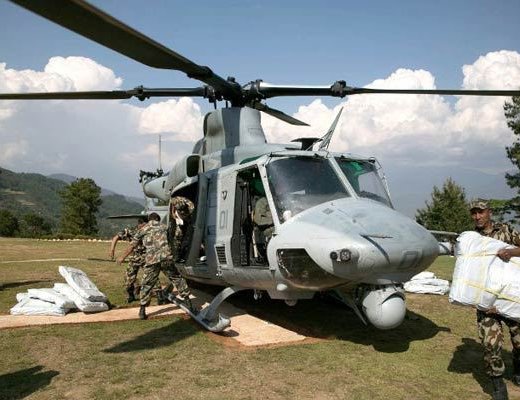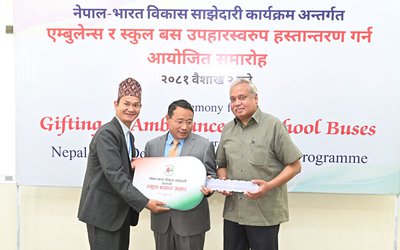
Although reconstruction is yet to start all over the country, Nepalese are slowly and gradually recovering from the trauma and tragedy of the devastating earthquakes of last year. In the process of revival and recovery, human and material contributions and sacrifice made by friendly countries have played a prominent role.
From the first day after earthquake till now, foreign countries have stood side by side with the Nepalese people. It will be remembered in Nepal for generations to come.
When the first earthquake hit Nepal on April 25 killing 9000 and affecting over 8 million, the situation was doomed and there was frustration, fear and disappointment. Thanks to the hand given by Nepal’s friends from near and far, the Nepalese slowly recovered from the trauma.
Indian rescue team landed with equipment within an hour of the quake. Similarly, China, Japan, Korea,United Kingdom, Germany and France also arrived with strong contingents. Even a small country like Israel sent a large rescue mission in Nepal with a hospital. United States came with equipment including helicopters and well trained marines.
Along with Nepalese Army and security personnel, U.S. Marine rescuers sacrificed their life in a mission to rescue Nepalese earthquake victims. On the way to rescue operation, six U.S. Marines died in a UH-1 Huge Helicopter that crashed on May 12, 2015. This sacrifice of six U.S. Marines, who came to provide humanitarian support to Nepalese will be remembered in Nepal for generations to come.
As Nepal commemorated a year of earthquake, Nepal’s international friends have expressed their solidarity to revive the hope of Nepalese people in providing financial assistance to build back better.
“We remember the courage of the many Nepalese and Americans who provided assistance to those in need. We also pay tribute to the six U.S. Marines, two Nepalese Army soldiers, and five Nepali civilians who were killed when their UH-1Y Huey helicopter crashed in the mountains of Nepal during relief operations on May 12, 2015. Our Marines were part of the U.S. effort that brought hundreds of tons of relief supplies, rescued many people in need, and partnered with the Government of Nepal and the Nepalese Army to support the international response,” said a press release issued by Public Affairs Section of Embassy of The United States.
“In our response, the U.S. Government effort relied on more than two decades of investment in disaster risk reduction activities in Nepal, and since the earthquake we have provided approximately $130 million for relief and recovery. Within hours of the earthquake, a Disaster Assistance Response Team (DART) was deployed to coordinate the U.S. government’s response efforts, conduct disaster assessments, and provide search and rescue capabilities. Our immediate humanitarian response included search and rescue deployments, emergency shelter, drinking water, food aid, and support to protect survivors against gender-based violence and human trafficking,” said a press release.
The United States stands alongside the people of Nepal, and we remain committed to Nepal’s efforts in housing and infrastructure, livelihoods and food security, health, water and sanitation, good governance, and the prevention and protection of vulnerable populations against gender-based violence and trafficking in persons.
European Union
Along with United States of America, the European Union has allocated 12.66 billion Nepali rupees (EUR 105 million) to support the Government directly through budget support in implementing recovery and reconstruction efforts, with strong focus on the promotion of resilience and disaster preparedness, the most vulnerable people as well as the principles of transparency and accountability in public finance management.
An additional amount of 2.30 billion Nepali Rupees (EUR 19 million) complements the reconstruction efforts with EU funded actions dedicated to relief, early recovery and humanitarian operations, including the provision of 650 Transitional Learning Centres.
The United Kingdom has allocated 10.6 billion Nepali rupees (EUR 89/£70 million) in response to the 2015 earthquakes. 5.3 billion Nepali Rupees/ £35m were disbursed for immediate needs, providing life-saving humanitarian assistance, restoring health services in the earthquake affected areas, re-establishing police support and financial services, and protecting livelihoods. This has included providing 250,000 people with live-saving shelter, 200,000 people with cold weather support, 100,000 people with immediate cash transfers, and supporting 125,000 women and girls with protection services and essential items.
Germany has allocated 3.6 billion Nepali rupees (EUR 30 million) for transition and recovery. The programs, that are implemented by GIZ and KfW in partnership with national authorities, cover areas like shelter, health, energy, education and livelihood-related activities. The beneficiary districts targeted under this action are Dhading, Nuwakot, Gorkha, Dolakha, Rasuwa, Ramecchap and Bhatktapur. A special focus will lie on the support for the rehabilitation of public infrastructure (important heritages sites, schools etc.) in Bhaktapur. In addition, private donations from Germany reached the amount of 13.9 billion Nepali Rupees (EUR 116 million).
Norway has contributed with around 3.6 billion Nepali rupees (EUR 30 million) for humanitarian aid and reconstruction. The humanitarian support was mainly directed to shelter, protection, health, livelihood, food security and education. In addition, support has been provided for reconstruction and retrofitting of schools and temporary reconstruction of Village Development Committees Offices.
Switzerland has allocated a total of 3.15 billion Nepali rupees (EUR 27.2/CHF 30 million) to postearthquake relief, recovery and reconstruction. Immediately after the earthquake Switzerland deployed more than 70 humanitarian aid experts to provide assistance in health, shelter, WASH and logistics in the amount of 525 million Nepali rupees (CHF 5 million).
Sweden has contributed approximately 1.27 billion Nepali Rupees (EUR 10.6 million) to the humanitarian work after the earthquake through the Swedish Civil Contingencies Agency (MSB).
The Netherlands contributed 1.2 billion Nepali rupees (EUR 10 million) for humanitarian aid in the context of emergency relief and reconstruction needs.
Denmark’s contribution of around 540 million Nepali rupees (EUR 4.5 million) focused on responding to humanitarian needs in the post-earthquake context, including projects on early recovery such as livelihoods stabilisation and enterprise recovery in earthquake affected areas.
Finland has allocated 250 million Nepali rupees (EUR 2 million) for reconstruction efforts mainly in water, sanitation and hygiene (WASH) and education sectors.
France directed its support to cover humanitarian needs, including projects on food security through non-governmental organisations, as well as reconstruction projects such as the Nava Prativa Secondary School and debris removal for an estimated total amount of 174 million Nepali rupees (EUR 1.45 million).
Along with bilateral agencies, multi-lateral agencies like the World Bank Group and Asian Development Bank have offered billion of rupees to finance reconstruction efforts of Nepal. The World Bank has offered up to half-a-billion dollars to finance the reconstruction of Nepal.
This consists of $200 million for housing reconstruction, which was approved by the World Bank Board of Executive Directors on June 29, 2015. This credit from the International Development Association (IDA), the World Bank’s fund for the poorest countries, will provide grants to home-owners to rebuild about 55,000 houses for the poor in rural areas.
Simialrly, Asian Development Bank continue to express their commitments for the reconstruction announcing packages for the school building reconstruction and other development.
As Nepal is in the process of reviving from the earthquake, the support of international agencies and Nepal’s friendly country is still important and valuable.

Keshab Poudel
Poudel is the editor of New Spotlight Magazine.
- ECONOMY: Growth At 3.3
- Apr 16, 2024
- DPM’s SHRESTHA’S CHINA VISIT High Profile, Low Key
- Apr 14, 2024
- Maha Kumbha In Barahkshetra: A Sacred Festival In Sacred Koshi (Kaushiki) River
- Apr 09, 2024
- LOSS AND DAMAGE: Upper Tamakoshi A Case
- Apr 02, 2024
- Helvetas-Nepal’s InElam Promoting Herbal Oil In Sarlahi
- Mar 31, 2024
















